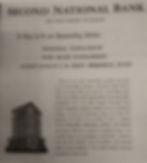
In part one of this series, we shared how Heavenrich Bros. & Co. began the city’s scholarship program in 1891. As explained in part two, the city had separate school districts, and the scholarship program began on the east side. Now we will take a closer look at how a few of these scholarships came to be. Saginaw residents have been generous over the years, and so the scholarships are too numerous to share them all in one post, so this is small selection that shows the diversity of how these scholarships began and evolved.
Donald R. McGee Memorial Scholarship

Don McGee is, perhaps, the most recognizable name among the memorial scholarships. “Birdman” McGee was Saginaw’s first aviator, and he made the first flight over the city of Saginaw in a plane he built himself on August 21, 1915.
It was a dramatic adventure. He took off from Merrill, but he had to land in a field near Gratiot after just 20 minutes in the air. The Saginaw Courier reported that he landed “on account of his motor being hot and himself rather tired from his exertions, he decided to land before attempting the dangerous flight over Saginaw.”
People came out to stare into the sky, having never witnessed an airplane in flight before. The news report continued, “Steadily and surely, the bird-like machine approached from the west, crossed the river, sailed over Genessee Avenue to Weadock, turned south and proceeded to the Realty company’s grounds at Sheridan and Washington where a landing was made.”
McGee learned about aviation through trial, error, and persistent experimentation. He became well known across the state, especially after his daring flight over Saginaw.
In 1917, McGee attempted to enlist in the Army to aid the allied efforts in World War I, but he was denied due to having had an operation just months before. McGee became a flight instructor. On Oct. 17, 1917, after dismissing his students, McGee went on a solo flight to relax. He ascended to 3,000 ft after which witnesses saw the plane suddenly nosedive into Lake St. Clair, killing McGee. No one knows for sure what caused the crash.
In memoriam, his good friend Paul F. H. Morley wrote, “...he designed and built tow aeroplanes and taught himself to fly, becoming an air pilot of fine ability. Upon the outbreak of the war, and at the first moment that his doctors would permit after his recovery from a severe operation, he offered his service to his county. Young McGee always regretted his lack of advanced technical education and hoped after the war, he might remedy this.”

Saginaw felt the loss of McGee, and the community wanted to do something to honor his life. Soon it was determined that $10,000 would be raised to fund the Donald R. McGee Memorial Scholarship. Morley noted that the award “would assist other young people in securing a higher education and in consequence enlarging their field of usefulness and service to the world.” He believed McGee would approve because “Don McGee knew of the struggle of combating financial handicaps in the carrying out of his own work.”
Money was quickly raised, and the first scholarship was awarded at commencement in 1919 to Arthur Plambeck.

Alumni Scholarship

The idea of alumni contributing to the success of students following in their footsteps repeats itself in the records of the United Scholarship Committee (precursor to the Saginaw Community Foundation administration of scholarships). The record is unclear if these attempts at Alumni Scholarships eventually blended into one.
According to the Saginaw High yearbook, the Senior Class of 1920 offered excess funds to the Alumni Association to start an alumni scholarship. “Profits from football games, plays, and yearbooks were added to the fund until April, 1935.” Following that point, the United Scholarship Committee took over administration of the scholarship.
Minutes from the trustees of the scholarship committee meeting on June 17, 1920, indicate that, the “Senior Class [of 1920] has given a play and had raised a considerable amount of money and that the Alumni Association has been very successful financially.” The Alumni Association decided to entrust that money to the United Scholarship Committee for its administration.
The desired qualifications for the awardee included: recommendation by faculty; character; scholastic achievement; participation in school activities along with leadership; “regard for authority, evidence of future public spirit, sense of service; all elements which make for a thorough and constructive American citizen.”
Here is where things get confusing. Another newspaper report notes that Saginaw High School Alumni established a scholarship fund to memorialize those alumni who had been killed in World War II. This is presented as a new scholarship, yet also administered by the same trustees. We have no notes that tell us explicitly that this scholarship merged with the former alumni scholarship. We can make an assumption that these became one alumni scholarship, but we caution readers that it is, indeed, just our best guess.
The Saginaw High School Alumni Memorial Scholarship effort began in 1945. The alumni committee sought contributions from former students and businesses with a goal of $50,000. The interest from the money was to be used as a gift scholarship to be paid in equal installments of $250 per year of college tuition at a 4-year institution.
Each graduating class was asked to organize contributions. The scholarship was viewed as a way to remember those Saginaw High graduates who had died. As with the first established Alumni Scholarship, the winner of this Saginaw High School Alumni Memorial Scholarship had to be a graduate of Saginaw High.
First award went to George Leo in 1946.
E. C. Fisher Engineering Scholarship

Margaret Fisher established a scholarship with the United Scholarship Committee in 1926 to honor her late husband, Elbert Curtiss Fisher. Fisher expected the scholarship to be administered like others that Heavenrich and the trustees had established, and she left the selection of the recipient to the committee. The minutes simple note that “This is a Mechanical Engineering Scholarship, a field in which Mr. Fisher was greatly interested and in which he was recognized by his fellow engineers as an authority. This scholarship is available to male students who desire to enter the engineering department of the University of Michigan.”
E. C. Fisher was a graduate of Cornell University, and he valued his education in engineering. He also served on the Saginaw Board of Education. It was a fitting tribute to create a scholarship in his honor.
As noted in part one, scholarships in this era were no-interest loans. Repayment after graduation was expected. The Fisher Scholarship was one of the first to become an outright gift. Max Heavenrich met with Margaret on December 28, 1947, while she was staying at the Bancroft Hotel, having returned to the city for a visit. By that point, she and her daughter had moved to New York City. In a follow-up letter dated Feb. 6, 1948, Heavenrich wrote:
Although we have continued to loan money to engineering students, we find that education has, like everything else, increased in cost and that the student, though willing and ambitious, leaves college (having borrowed money for a college education) with the handicap of a financial obligation that prevents his best efforts in his profession, and may cause mental anxiety as to how he could pay his loan, and decrease his efficiency.
Subsequent exchange of letters indicate that Fisher was the first to broach the subject with Heavenrich at their Bancroft meeting. Heavenrich asked for written approval to amend the original agreement and turn the scholarship loan into a scholarship gift, which Fisher promptly supplied.
By June of 1946, the scholarship was formally amended, and from that point the E. C. Fisher Engineering Scholarship was administered as a gift rather than a loan, leading the way for other scholarships to make the same transition. It is also interesting to note that the criteria was also amended to say it would be awarded to a student pursuing education in engineering rather than a male student.
The first recipient was Theodore N. Will, valedictorian of the Class of 1926.
A note about C.K. Eddy Memorial Fund in the picture above:
The C. K. Eddy Family Memorial Fund was established after the lumberman’s death in 1901 by his son Arthur Eddy. The scholarship funds were made available to Saginaw County students who attended college in Michigan. This scholarship remained separate from the scholarships administered by the United Scholarship Committee.
